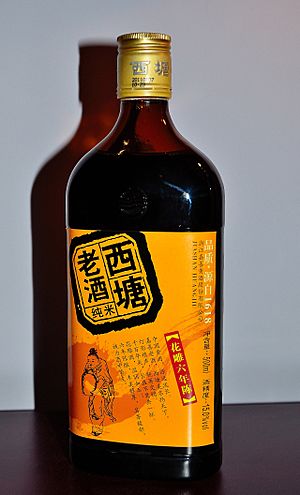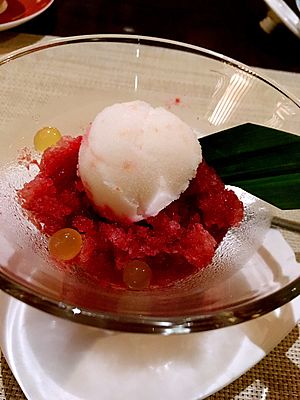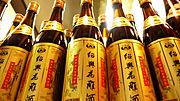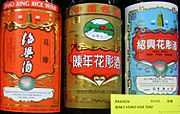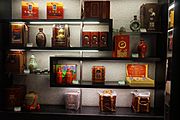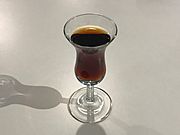Huangjiu facts for kids
Quick facts for kids Huangjiu |
|||||||||||
|---|---|---|---|---|---|---|---|---|---|---|---|
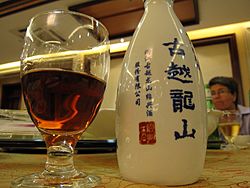
A glass of Shaoxing wine, a variety of huangjiu
|
|||||||||||
| Simplified Chinese | 黄酒 | ||||||||||
| Traditional Chinese | 黃酒 | ||||||||||
| Hanyu Pinyin | huángjiǔ | ||||||||||
| Literal meaning | yellow wine | ||||||||||
|
|||||||||||
Huangjiu (Chinese: 黄酒), which means "yellow wine," is a traditional Chinese drink. It's very popular in the Jiangnan area of China. Huangjiu is made by mixing cooked grains like rice, glutinous rice, or millet with a special starter called qū. This mixture then goes through a process called saccharification (turning starches into sugars) and fermentation (turning sugars into alcohol). This happens at cool temperatures, usually for about two weeks. Huangjiu typically has an alcohol content of 8% to 20%.
Before it's sold, Huangjiu is usually heated to kill any unwanted germs, a process called pasteurization. This also helps keep its flavors stable. It's also aged and filtered. Aging is very important for developing its rich flavors and smells. Some top-quality Huangjiu can be aged for up to 20 years! Even though its name means "yellow wine," its color can range from clear to light yellow, orange, or even brown. Many famous Huangjiu makers say that the quality of the water they use is key to making the best wine. Some even think it's the most important ingredient.
Huangjiu is often enjoyed warm, as warming it helps release its rich flavors. In summer, some people like to drink sweeter types of Huangjiu chilled or with ice. Liaojiu (料酒) is a special kind of Huangjiu used for cooking. A good example is the cooking version of Shaoxing rice wine. The main places that make Huangjiu are China and Taiwan.
Contents
A Look at History
For a long time, Huangjiu was as important in China as beer was in Europe. Long ago, ancient Chinese people made a drink similar to beer. But then, they discovered how to make alcohol using qū, and Huangjiu quickly became the favorite. Beer-like drinks were forgotten in China until the 1800s. That's when Germans brought breweries back, leading to famous beers like Tsingtao.
Huangjiu has always been China's favorite brewed alcoholic drink. The earliest form of Huangjiu is believed to have been created by a person named Dukang during the time of the Xia dynasty. Dukang later became known as the Chinese god of wine.
Today, Huangjiu is found all over China, especially in the Jiangnan area. Some well-known types of Huangjiu include Guyue Longshan, Kuaijishan, and Tapai from Shaoxing, and Huiquan Jiu from Wuxi.
Different Kinds of Huangjiu
Huangjiu is made in many places across China, and there are many different kinds. They can be grouped based on how dry or sweet they are, the type of qu (starter) used, and how they are made.
Sweetness Levels
Chinese wines are officially sorted into five groups based on their sugar content:
- Dry (Gan, 干 / 乾): These have very little sugar, less than 1%. They are fermented at the lowest temperatures. An example is Yuanhongjiu (元红酒), which means "Champion's Red Wine." It's a special wine from Shaoxing. It got its name because passing the old imperial exams was a big reason to celebrate, and the wine jars were traditionally painted red.
- Semi-dry (Ban Gan, 半干 / 半乾): These have a little more sugar, between 1% and 3%. This type of Huangjiu can be stored for a long time. Most Huangjiu exported from China falls into this group. An example is Jiafanjiu (加饭酒), meaning "Added Rice Wine." It's a version of Yuanhongjiu made with more rice during fermentation. Jiafanjiu is often used for special family events like births, engagements, and funerals.
- Semi-sweet (Ban Tian, 半甜): These have a sugar content between 3% and 10%. The longer semi-sweet Huangjiu is stored, the darker its color becomes. An example is Shanniangjiu (善酿酒), a special wine from Shaoxing that uses aged Yuanhongjiu instead of water in its making.
- Sweet (Tian, 甜): These have a sugar content between 10% and 20%. An example is Feng Gang Jiu (封缸酒), meaning "Conceal Earth Jar Wine." Unlike other types, sweet Huangjiu can be made all year using traditional methods.
- Extra-sweet (Nong Tian, 浓甜): These are very sweet, with 20% sugar or more. An example is Xiang Xue Jiu (香雪酒), meaning "Fragrant Snow Wine."
Types of Starter (Qu)
The type of qu (starter) used also changes the Huangjiu:
- Xiaoqu (小曲 / 小麴): This starter uses rice mixed with certain molds, yeast, and other tiny living things. It creates less heat during fermentation and is mostly used in southern China.
- Daqu (酒曲 / 酒麴): This starter uses rice with Aspergillus oryzae mold and yeast. Most popular Chinese alcoholic drinks use this type.
- Hongqu (红曲 / 紅麴): This starter uses red rice molds, especially Monascus purpureus. These molds give the wine a red or purple color and add flavor.
How It's Made
Different ways of making Huangjiu also create different types:
- Tangfan (烫饭 / 燙飯): The steamed rice used for the wine is cooled in the open air until it's still warm before being processed.
- Liangfan (凉饭 / 凉飯): The steamed rice is cooled with cold water before further steps. The leftover mash from this wine is sometimes eaten as a dessert.
- Jiafan (加饭 or 喂饭): More steamed rice is added to the fermenting mixture over time (up to three times). This makes a sweeter wine.
- Fortified: Another strong Chinese alcohol called Baijiu is added to the fermenting mix. This stops the fermentation process and leaves a lot of unfermented sugars, making the wine extra sweet.
Popular Huangjiu Types
Here are some of the most popular kinds of Huangjiu:
- Mijiu (米酒): This is a general name for Chinese fermented rice wine, similar to Japanese sake. It's usually clear and used for both drinking and cooking. Cooking Mijiu often has salt added. It typically has 12–19.5% alcohol.
- Fujian Laojiu (福建老酒)
- Su-shi Laojiu (苏式老酒): This means "Su-style old wine." Huiquan jiu is a famous example of this type.
- Fujian Nuomijiu (福建糯米酒): This wine is made by adding many expensive Chinese medicinal herbs to glutinous rice and a low-alcohol distilled rice wine. It's special because it uses another wine as a starting material instead of water. It has an orange-red color and about 18% alcohol.
- Jiafan jiu (加饭酒)
- Huadiao jiu (花雕酒): Also known as nu'er hong (女儿红), which means "daughter red." This type of Huangjiu comes from Shaoxing in Zhejiang province. It's made from glutinous rice and wheat. This wine comes from an old Shaoxing tradition: when a daughter was born, nu'er hong was buried underground. It was then dug up for her wedding party. The jars were decorated with colorful carvings, which is how it got the name "flowery carving wine." Huadiao jiu has about 16% alcohol.
- Shaoxing jiu (绍兴酒 / 紹興酒): This wine is widely used for both drinking and cooking in Chinese food. Its reddish color comes from red yeast rice. A well-known producer is Zhejiang Guyue Longshan Shaoxing Wine Co., Ltd. Some Shaoxing wine can be aged for 50 years or even more!
- Honglu jiu (红露酒 / 紅露酒): Meaning "red wine," this is made in Taiwan. In the early 1900s, some business people made Chinese red rice wine that was aged longer than others. After World War II, one of their brands, "Yellow Rooster," was renamed Honglu jiu.
- Liaojiu (料酒): Meaning "ingredient wine," this is a lower-grade Huangjiu widely used in Chinese cooking as a cooking wine. It's often sold with flavors and spices like cloves, star anise, cassia, black cardamom, Sichuan pepper, ginger, nutmeg, and salt.
How Huangjiu is Made
The three main things needed to make Chinese alcoholic drinks are grain, water, and qu (starter). Other things might be added to change the color, taste, or even for traditional medicinal reasons.
Main Ingredients
- Grains: The first grains grown in China were millet in the north and rice in the south. Both are still used to make alcohol today. Modern makers also use wheat, barley, sorghum, and coixseed. For Huangjiu, the grains are cleaned and polished. Then, they are soaked in water that has been made a little sour. This souring helps stop bad microbes from growing, which could spoil the drink. This process also gives Huangjiu its special taste.
- Water: Water helps the grains soak up liquid and allows the fermentation to happen. The water's pH level and minerals also affect the drink's flavor and quality. Many places are famous for their drinks because of their clean water sources. Makers try to get the purest water from springs, streams, or the middle of lakes. The best water for Huangjiu has low iron and sodium, but more magnesium and calcium.
- Starter (Qu): The starter, called Jiuqu or just Qu, is usually a dried cake made of flour. It contains different molds, yeasts, and bacteria. To make Huangjiu, this cake is crushed and added to the grains. The molds and yeasts in the qu produce enzymes that break down the grains into sugars. Then, other yeasts and bacteria turn these sugars into alcohol.
- There are three main types of qu:
- Xiaoqu (小曲 / 小麴): A small cake (10-100g) of rice flour, grown with microbes at cool temperatures. It's the most common starter for Huangjiu.
- Daqu (大曲 / 大麴): A larger cake (1–5 kg) made of wheat, or wheat and pea flour, grown with microbes at higher temperatures. It's mainly used for another Chinese alcohol called Baijiu, but sometimes used with Xiaoqu for Huangjiu. It changes the taste of the wine a lot.
- Hongqu (红曲 / 紅麴): Dried rice grains covered in mold. The main mold, Monascus purpureus, makes a red color that dyes the wine red or purple. It's often used with Xiaoqu to make red grain wines.
- There are three main types of qu:
Preparation Steps
Seed Mash
Before making the main batch of Huangjiu, a smaller batch called the "seed mash" (酒母, jiǔmǔ) is prepared. This involves soaking and souring glutinous rice and other grains, then steaming them. Steaming cooks the grains and makes their starch easier for the starter to use. The steamed grains are cooled to a specific temperature (23 to 28 °C) before the small starter is added. This is the best temperature for the seed mash to start fermenting.
After adding the small starter, it takes about two days for the grains to start turning into sugars and alcohol. When the steamed grains begin to turn into a liquid, the big starter and more water are added to form a thick mixture. This mixture is carefully stirred to make sure it has enough oxygen and to keep the temperature even. The mixture is stirred for about a week. Then, it ferments more fully for about a month. After this, the alcohol content rises to about 15%. This is the seed mash that will be used to make the main batch of Huangjiu.
Main Mash
More soaked and soured rice is prepared just like for the seed mash. This grain is then cooled, either with cold water or by being left out in the open, depending on the type of Huangjiu being made. The seed mash, another big starter, and fresh water are then mixed with this grain in large, glazed earthenware pots. The mixture is gently pounded on the sides of the pots.
Aging
Similar to how Japanese sake is made, the process of turning starch into sugar and then into alcohol happens at the same time in the same mixture. The seed mash and starter work on the cooked rice. After this, the mixture is left to age in earthenware jars. This aging can last from a few months to many decades before the Huangjiu is bottled and sold.
Gallery
See also
 In Spanish: Huangjiu para niños
In Spanish: Huangjiu para niños


